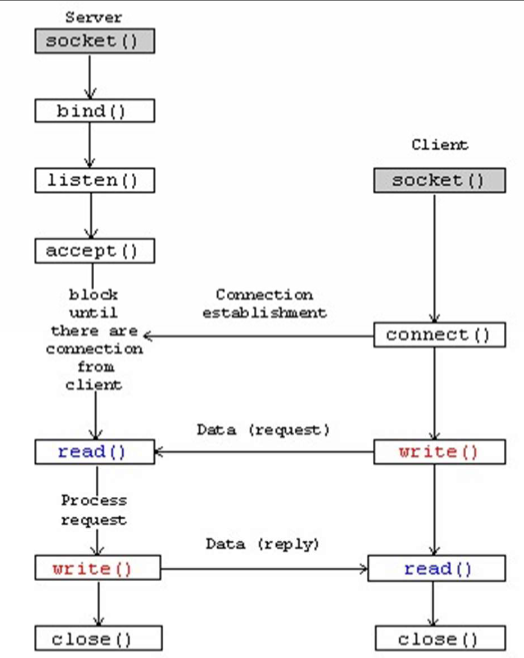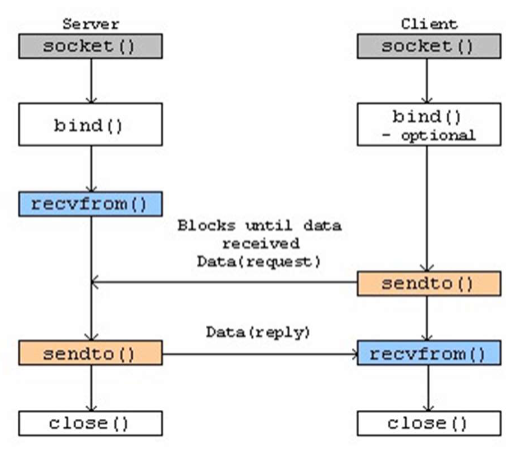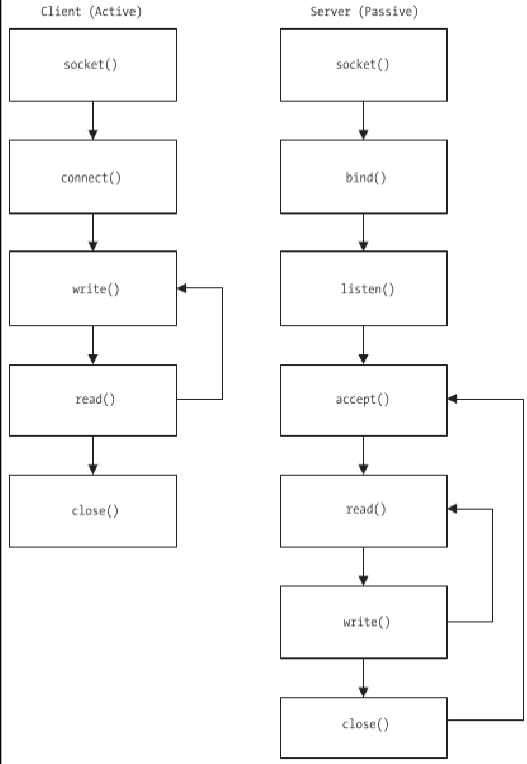The course provides information about TCP and UDP connection using C programs to demonstrate basic communication instructions and usages in a Server-Client environment.
| TCP | UDP |
|---|---|
| Reliable | Unreliable |
| Connection-oriented | Connectionless |
| Segment retransimission and flor control through windowing | No windowing or retransimission |
| Segment sequencing | No sequencing |
| Acknowledge segments | No acknowledgement |
- TCP is a stream type protocol. It makes sure that the transmission between sender and recipient is stable by checking the flow of the transmission.
- UDP on the other hand is a datagram type protocol. It is unreliable compared to TCP, but it is faster when it comes to low latency.
| TCP | UDP |
|---|---|
 |
 |
Further documentation about sockets, server-client interaction, TCP and UDP, visit the files linked below:
Ports and addresses are always specified in calls to the socket functions using the network byte order convention. Host byte order sorts bytes in the manner which is most natural to the host software and hardware. There are two common host byte order methods:
- Network Order uses Little-endian: byte ordering places the least significant byte first
- Host Order uses Big-endian: byte ordering places the most significant byte first
The following C functions allow the application program to switch numbers easily back and forth between the host byte order and network byte order without having to first know what method is used for the host byte order:
htonl()or host to network long: translates an unsigned long integer into network byte order.htons()or host to network short: translates an unsigned short integer into network byte order.ntohl()or network to host long: translates an unsigned long integer into host byte order.ntohs()or network to host short: translates an unsigned short integer into host byte order.
When setting up a socket, it is required to choose the address family, the type of service and the protocol used by the socket.
Common address faimilies are:
AF_INETandAF_INET6sockets provide a means of communicating between application programs that are on different systems using the TCP and UDP transport protocols provided by a TCP/IP product.xAF_IUCVsockets provide communication between processes on a single VM system, or on a group of systems that share IUCV connectivity.AF_UNIXsockets provide communication between processes on a single VM system, or on a group of systems that share a single Byte File System (BFS) server.
The AF_INET uses the following addresses:
typedef unsigned long in_addr_t;
struct in_addr { in_addr_t s_addr; };
struct sockaddr_in {
unsigned char sin_len; /* length of sockaddr struct */
unsigned char sin_family; /* addressing family */
unsigned short sin_port; /* port number */
struct in_addr sin_addr; /* IP address */
unsigned char sin_zero[8]; /* unassigned */
};socket(AF_INET, SOCK_STREAM, 0)Takes as parameters the address family, the type of socket and the networking protocol to use. By default, 0 is used, letting the system determine the appropriate protocol to use.
struct sockaddr_in sa;
// ...
bind(s, (struct sockaddr *) &sa, sizeof sa)Used to assign to the socket s the number of the port on which the server wants to provide it's server (struct sockaddr *) &sa and the IP address of the network connection.
The server puts the port number and IP address into a sockaddr_in structure, passing it and the socket file descriptor to the bind() function.
listen(s, backlog_number);The server now intends to listen for connections on this socket. listen() puts the socket into passive open mode and allocates a backlog queue of pending connections. In passive open mode, the socket is open for clients to contact.
struct sockaddr_in sa;
int addrlen;
// ...
client_sock = accept(s, (struct sockaddr *) &sa, &addrlen);Used by the server to accept a connection request from a client. When a connection is available, the socket created is ready for use to read data from the process that requested the connection. The call accepts the first connection on its queue of pending connections for the given socket socket.
write(socket, MESSAGE, strlen(MESSAGE));
close(socket)write() sends a buffer (MESSAGE) to the socket and close() closes the communication established with that socket.
